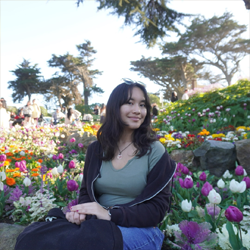Taylor Aguon
 Taylor Aguon ‘26 (she/her) is a fourth-year Biology major and identifies as Japanese and an indigenous Guam Pacific Islander, CHamoru. We are thrilled to have Taylor as one of our AAPI Center research assistants! In our spotlight, she shares her experiences as a multi-racial college student and the importance of honoring the heterogeneity of AAPI communities.
Taylor Aguon ‘26 (she/her) is a fourth-year Biology major and identifies as Japanese and an indigenous Guam Pacific Islander, CHamoru. We are thrilled to have Taylor as one of our AAPI Center research assistants! In our spotlight, she shares her experiences as a multi-racial college student and the importance of honoring the heterogeneity of AAPI communities.
Tell me about yourself and your work at the AAPI Center.
I grew up on Guam as an indigenous CHamoru, but my culture was not the predominant one. CHamoru is a dying language and culture on Guam and I felt disconnected with that side of my identity. Meanwhile, being Japanese on Guam was complicated given the tension between the two after World War II.
I found connection to both cultures through a passion for the environment and respect for the land. In fact, it was one of the only things remaining of CHamoru culture that I could connect with. The importance of the environment in both Japanese and CHamoru culture inspired my work with endangered birds and snakes on Guam.
My interest in science and work with endangered birds solidified my interest in a career within science. While I didn’t plan to go to college off island, it was always a dream for me to introduce people to Guam and gain new skills and experiences to bring back to my community. I had an opportunity to transfer to USF and seized the chance last year.
Last Spring, I was introduced to the AAPI Center and started working with them on various projects. Some of these include: social media, event planning, and most recently, conducting interviews with learning community participants as part of Center’s research project. My work with the AAPI Center has helped me develop a community at USF. It’s difficult for transfer students to find community, especially when you are not from the States. I have learned so much from the people I work with and have even found a group of people who have similar cultural experiences.
What does it mean for you to identify as AAPI? What is something you want others to know about AAPI communities?
I do not have a positive experience with the label AAPI. It is a label that is overly general and does not capture the distinct differences between Asian American and Pacific Islander communities. While completing forms to move to the States, I noticed that these identities were often grouped together as ‘Asian Pacific Islander’. In my lived experiences, these two identities were very different and could not be considered the same; it felt invalidating to keep seeing them grouped together.
I want people to know that AAPI communities are not all the same. Not only is the Asia Pacific one of the largest regions in the world, but it also captures a diverse group of people. One label for such a large amount of people is insufficient and has been one of the hardest things I have dealt with here in the States.
For example, if I tell people that I am Asian and Pacific Islander, they often think it is the same thing. Then, when they misunderstand, it feels like I have to do a lot of explaining to help them understand that there is a difference. For example, when I have shared that I am an indigenous Pacific Islander, people have assumed I was Hawaiian. When I shared that I was from Guam, others thought Guam was part of the Philippines or China. It is tiring when people assume they understand more about me than they actually do.
What change are you looking forward to?
In my work on the APIA Scholars Scholar Advisory Committee, I want to help improve the academic opportunities for underserved communities in Guam and more broadly, for Asian and Pasifika students. Many do not know that higher education can be highly inaccessible for Asian and Pasifika students. For example, there is only one university on Guam. If someone wants to pursue a major that is not provided at that university, the student needs to travel across the ocean to access these opportunities. Ultimately, I hope I can work to increase the accessibility of higher education for Asian and Pasifika students.
Aside from advocacy, I want to contribute to work being done to preserve Guam’s natural environment. I hope that my studies at USF will equip me with a unique skillset that I can bring back to Guam.